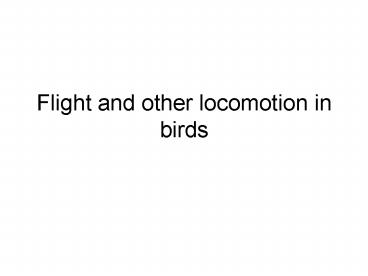Flight and other locomotion in birds - PowerPoint PPT Presentation
Title:
Flight and other locomotion in birds
Description:
Continuous-vortex gait. High speeds. Flight Recap. Amount of drag is ... The leading edge Vortex. The 'LEV' of a swift. Low pressure zone. On top of wing ... – PowerPoint PPT presentation
Number of Views:548
Avg rating:5.0/5.0
Title: Flight and other locomotion in birds
1
Flight and other locomotion in birds
2
Lift of a wing
- Bernoulli effect pressure is inversely related
to number of particles moving in a single
direction (fluids). - Newtons 3rd Law for every action there is an
equal and opposite reaction.
3
Static airfoil (wing)
4
Angle of Attack
Vacuum
If angle of attack gt 5, wing starts to produce
vorticies. These can lead to stall
5
Solution alula (bastard wing)
- Particularly important at low speeds and high
angles of attack
6
A
1s
Low Speed (take-off and landing) High Angle of
Attack
7
- Landing
8
Eoaluavis
- Sanz et al. 1996 Nature
- Eoalulavis hoyasi
- Los Hoyas, Spain
- Goldfinch sized bird
- 115mya
- 30my after Archaeopteryx
- low speeds
- high maneuverability
Florescent induced photo
9
Drag
- Resistance caused by friction of air moving over
the surface of the wing - Induced drag occurs when the air flow separates
from the surface of a wing - Air moves from high to low pressures
- fills vacuums created by wing
- Profile drag is due to the friction between the
air and bird moving through the air - Minimized by low profile (aerodynamic anatomy)
- i.e. thin leading edge of wing
10
Induced Drag
- Di - induced drag
- A - aspect ratio
- k - constant
- L - lift
- S - wing area
- Ve - airspeed
- ? - air density
High speed
Low speed
11
Profile Drag
D is the force of drag, ? is the density of the
fluid, v is the velocity of the object relative
to the fluid, A is the reference area, and Cd
is the drag coefficient
D
Airspeed
12
Drag Curve
aka Profile drag
13
- 2 gaits of a bird
- Vortex-ring gait
- Low speeds
- Continuous-vortex gait
- High speeds
14
(No Transcript)
15
Flight Recap
- Amount of drag is affected by
- Body size
- Speed
- Wings surface area and shape
- Environmental factors
- Viscosity etc.
16
Wing shape
- Aspect Ratio Length / width
- Range 1.5-18.0
17
Gliding Wing
- Laysan Albatross
18
High Speed Wing
19
Explosive, Maneuverable Wing
- Grouse Wing
20
- Table of Wing loading body mass / wing area
Species or group Wing-loading
Swallows 0.15
Passerines 0.2 - 0.4
Hawks 0.3 - 0.5
Waterfowl 0.8 - 1.0
Pied-billed Grebe 1.2
Loons 1.4 link
21
Wing loading
low
high
22
Contribution of the hindlimbs
- Varies over species
- May be very important (Starlings 80-90 of
take-off velocity due to hindlimb contribution)
Earls 2000
23
- Hummingbirds
- 46-59
- Variability depends upon motivation
- Autonomous 59
- Escape 47
- Aggressive (chasing conspecific male) 46
Tobalske et al. 2004
24
The leading edge Vortex
- The LEV of a swift
Videler et al. (2004)
Low pressure zone On top of wing Wing wants to
fill the low pressure zone thereby creating
lift Can be used for maneuverability (each wing
independent)
25
Wing slotting
26
Different Modes of Flight
- 1. Gliding Vs/V (sinking speed horizontal
speed) - Glide ratio of 20
- 2. Soaring maintain altitude w/o flapping.
- Thermals (see drawing) and updrafts (slope
soaring) - Dynamic soaring
Obstruction lift Or slope soaring
27
- Hawk mountain
east
Kettle valley
28
Dynamic Soaring
- 1 - climb (windward flight)
- 2 - upper curve (change of flight direction to
leeward) - 3 - descent (leeward flight)
- 4 - lower curve (change of flight direction to
windward) (Sachs 2005).
video
29
3. Flapping flight
- Video of a starling in a wind-tunnel
- Downstroke (power stroke) flex wing
depressors - lift. - Upstroke (recovery stroke) flex wing
elevators - minimize drag. - Slotting
Cockatiel flying at 1m/sec
30
Flapping (cont)
- Flapping is usually intermittent in small species
- And varies w/ speed
Flap-glide
Flap-bound
Budgerigars in wind-tunnel (Tobalske and Dial
1994)
31
4. Hovering
- Flapping while maintaining horizontal position
- Examples
32
5? Formation Flying
- Saves energy (11-14)
- Coupled with full belly even more (Kvist et al.
2001)
low
high
33
Note on metabolism and flight
Predicted
Observed
34
Other forms of locomotion in birds
- Running, walking, hopping, waddling
- Head bobbing
- Ostriches
- Climbing
- Nuthatches, woodpeckers
- Swimming
- Ducks
- Diving
- Penguins, Auks































